¿Es difícil el paddle surf ? Muchas personas pueden preguntarse esto cuando se acercan por primera vez a este deporte. Si usted es una de ellas, no se preocupe. En este artículo encontrará una respuesta completa y consejos para que su proceso de aprendizaje sea más sencillo.
Entonces, ¿Qué tan difícil es el surf de remo ? ¡A continuación, te contamos la respuesta!
¿Es difícil el paddle surf para principiantes?
No, el surf de remo no es difícil para principiantes. Con la orientación adecuada, cualquiera puede convertirse en un remador experimentado en cuestión de horas. El surf de remo es un deporte acuático fácil, divertido y terapéutico apto para todas las edades y niveles de condición física. Este deporte ejercita todo el cuerpo, promueve el equilibrio y la resistencia y ofrece beneficios terapéuticos.
4 beneficios del paddle surf para principiantes
El paddle surf es un deporte que aporta numerosos beneficios a la salud física y mental. A continuación, se enumeran algunas de las principales ventajas:
1. Entrenamiento de cuerpo completo
Dado que el surf de remo involucra varios grupos musculares a la vez, es una alternativa refrescante y eficiente para los ejercicios prolongados en el gimnasio. El surf de remo se centra principalmente en la parte superior del cuerpo al moverse por el agua. Los músculos de las piernas y los estabilizadores del torso son necesarios para mantener el equilibrio al navegar por diferentes tipos de agua. Este acto de equilibrio dinámico es excelente para aumentar la resistencia y la fuerza muscular.
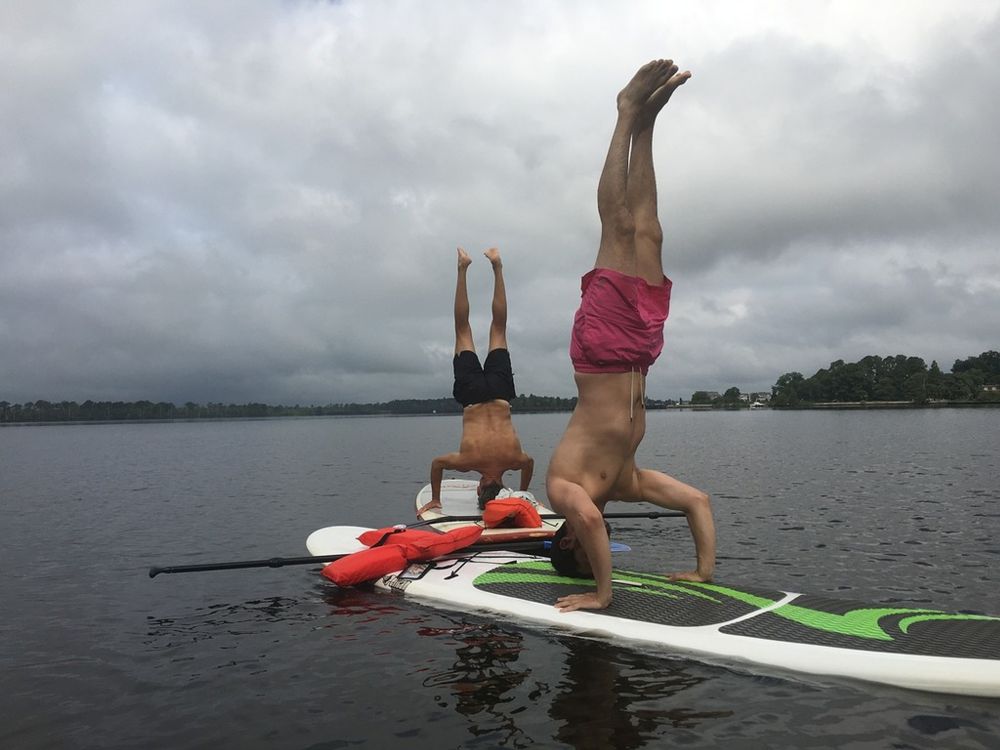
El SUP incluye ejercicios para la espalda, los brazos, las piernas, los hombros y el torso. Cada brazada involucra una amplia gama de músculos de la parte superior del cuerpo mientras se mantiene el equilibrio sobre la tabla en constante movimiento, lo que mantiene las piernas, las caderas y el torso en constante trabajo. Si desea aprovechar al máximo sus ejercicios acuáticos, considere las tablas de remo diseñadas para una máxima condición física.
2. Mejorar la salud cardiovascular
El ejercicio frecuente se asocia con una mejor salud cardiovascular, y quienes llevan un estilo de vida físicamente activo a menudo experimentan tasas reducidas de enfermedad cardíaca coronaria. Esto es especialmente cierto en el surf de remo, que no solo aumenta la frecuencia cardíaca durante el ejercicio, sino que también la mantiene elevada, lo que garantiza un entrenamiento cardiovascular vigoroso.
El surf de remo es más que una actividad de entrenamiento de fuerza, es una rutina cardiovascular completa que aumenta la frecuencia cardíaca mediante el remado constante. El ejercicio cardiovascular regular es esencial para mantener la salud cardiovascular y reducir el riesgo de enfermedades cardíacas. Los beneficios cardiovasculares del surf de remo son similares a los del ciclismo o los ejercicios aeróbicos, lo que lo convierte en una excelente opción para mejorar la salud cardíaca y prevenir enfermedades cardiovasculares.
3. Fortalecer los músculos centrales
Reducir las molestias en la espalda, evitar lesiones, proteger los órganos internos y mejorar la postura dependen de un core fuerte. Dado que los músculos del core actúan como estabilizadores del cuerpo, el stand up paddle boarding es un método divertido y práctico para desarrollar la fuerza del core. Aprender a mantener un buen equilibrio sobre una tabla de stand up paddle es una excelente manera de trabajar estos músculos. Tus músculos del core estarán más fuertes sin que te des cuenta.
4. Reducir el estrés
El surf de remo es una forma única de desconectarse de los factores estresantes diarios y disfrutar de un entorno rico en sensaciones. Estar al aire libre y rodeado de agua puede reducir los niveles de hormonas del estrés y cortisol en el cuerpo y mejorar el estado de ánimo.
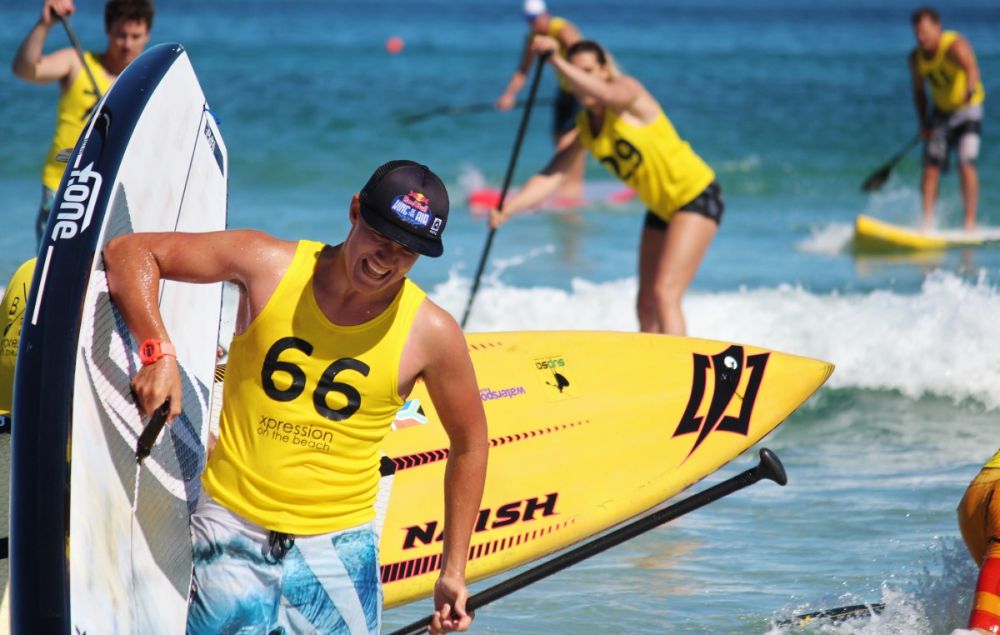
El paddle surf también es una actividad meditativa en la que las brazadas constantes fomentan un estado de ánimo tranquilo y rítmico. Esta técnica ayuda a la quietud mental y mantiene la concentración en la presencia, que es muy similar a la atención plena cuando necesitas despejar tus pensamientos de distracciones y preocupaciones.
Además de proporcionar una vía de escape de la vida cotidiana, el SUP promueve una mayor sensación de bienestar. El ejercicio, que libera endorfinas de forma natural, combinado con el entorno tranquilo de remar en aguas abiertas, produce una potente cura para el estrés.
¿Cómo hacer que el paddle surf sea fácil?
Aprender a hacer paddle surf no es demasiado difícil. Nuestras pautas a continuación te ayudarán a sentirte menos desafiado al comenzar tu excursión acuática.
Elija el tamaño y tipo de tablero adecuados
Debes elegir el tipo y tamaño de tabla de remo adecuado para tu actividad acuática en función de su longitud, anchura y capacidad de peso. Los principiantes prefieren las tablas de remo todoterreno, que suelen tener entre 3 y 3,5 m de largo y entre 80 y 90 cm de ancho. Estas tablas son bastante estables para practicar el equilibrio.
Las tablas diseñadas para principiantes suelen tener una plataforma más ancha, una punta y una cola más grandes y otras funciones como agarraderas, configuración de aletas y sistemas de bungee. Debes familiarizarte con estas características para garantizar una experiencia perfecta.
Elige la vía navegable
¿Qué tan difícil es el paddle surf ? El nivel de dificultad puede depender de la vía fluvial que elijas. Seleccionar la zona de agua adecuada proporciona una experiencia más tranquila, especialmente para principiantes. Debes optar por aguas tranquilas y protegidas con poca o ninguna multitud para que puedas dominar la técnica sin las dificultades adicionales causadas por las olas, los vientos y la congestión.
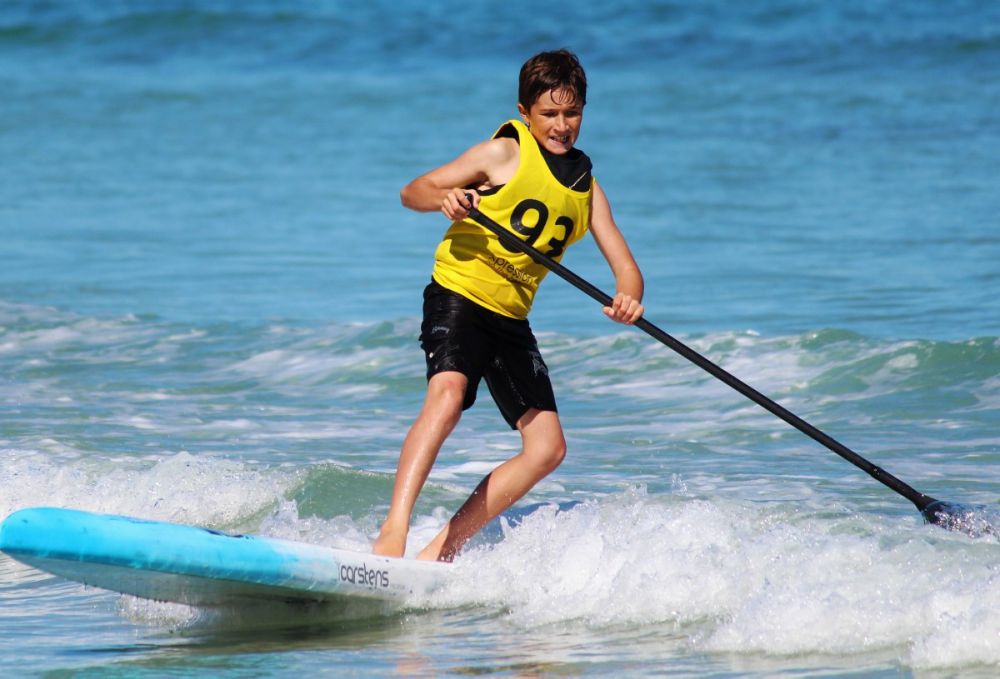
Una de las mejores opciones son los lagos, ya que no tienen olas grandes, corrientes fuertes ni corrientes rápidas como los ríos o los océanos. Sin embargo, debes estar preparado para el clima helado y los vientos en estas aguas tranquilas.
Por lo tanto, antes de salir a remar por primera vez, si no estás seguro de las condiciones, pregunta a tu alrededor. Los remadores expertos o las personas que trabajan en una tienda de alquiler de tablas de remo pueden darte consejos importantes.
Coger olas puede ser un desafío para los principiantes en el remo. Remar manualmente puede ser difícil y cansarte más rápido, lo que afecta negativamente a tu disfrute de los momentos. Sin embargo, Boost Fin puede hacer el trabajo pesado. Esta quilla eléctrica motorizada para tabla de surf te ayudará a coger una ola fácilmente, como si volaras sobre el agua.
Elige la forma correcta de remar
¿Es fácil hacer paddle surf ? Sí, puede ser más fácil si remas correctamente. Cuando uses una tabla de surf de remo, asegúrate de que la pala esté completamente sumergida y que el logotipo esté orientado hacia afuera sumergiendo el mango del remo en el agua detrás de ti. Si quieres girar la tabla, debes sumergir la pala en el agua y tirar de ella hacia atrás.
Elija la postura y posición correctas
Una postura y una posición adecuadas te ayudarán a realizar golpes eficientes y efectivos. En general, debes mantener un equilibrio firme manteniendo los pies separados y las rodillas ligeramente flexionadas.
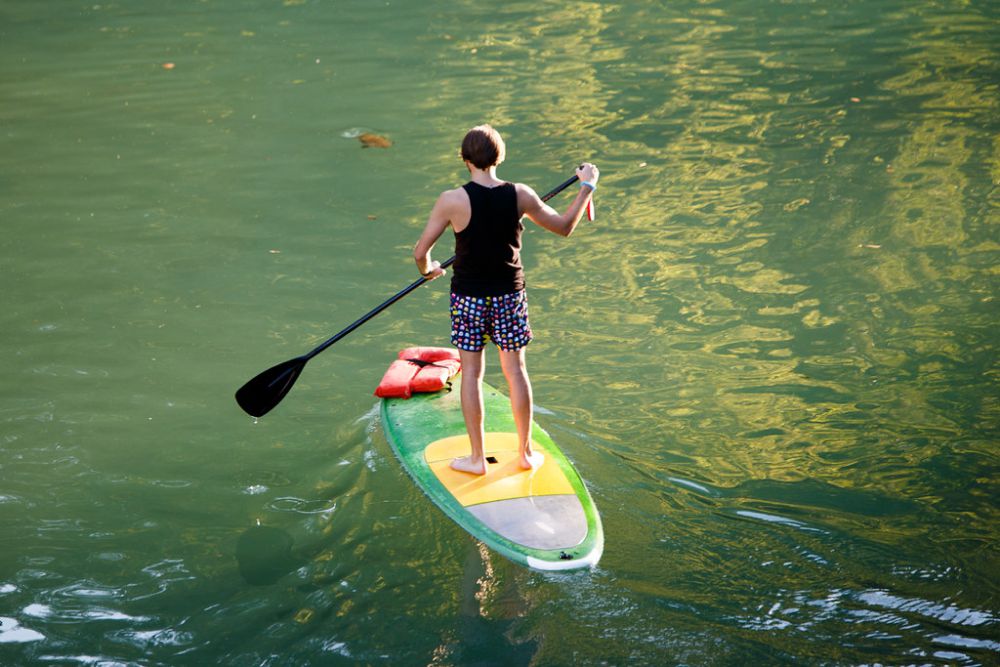
Recuerda mantener una base firme e inclinarte hacia adelante mientras remas para ganar impulso durante tu excursión acuática. Una vez que comprendas la mecánica de sostener y mover el remo, podrás tener una mejor postura, disminuir la posibilidad de agotamiento y disfrutar más de la actividad.
¿Cómo hacer que practicar paddle surf con amigos sea más divertido?
El paddle surf será más divertido cuando tengas más amigos que te acompañen.
Cuando estés de pie sobre la tabla de remo con tu compañero, intercambia mensajes claros y coordina las brazadas. Comienza de rodillas o siéntate y, luego, aumenta gradualmente hasta llegar a la posición de pie. El ritmo lleva tiempo, así que prepárate para las caídas y las risas. Asegúrate de que solo haya un remador porque puede resultar complicado sincronizar las brazadas, lo que puede dar lugar a situaciones peligrosas.
No habrá problema si quieres llevar a tu mascota en la tabla de surf de remo. Sin embargo, hay algunas cosas que debes hacer para garantizar la seguridad de ti y de tus amigos peludos. Dale a tus perros unos días para que se acostumbren a estar de pie en la tabla de surf de remo en tierra antes de llevarlos al agua.
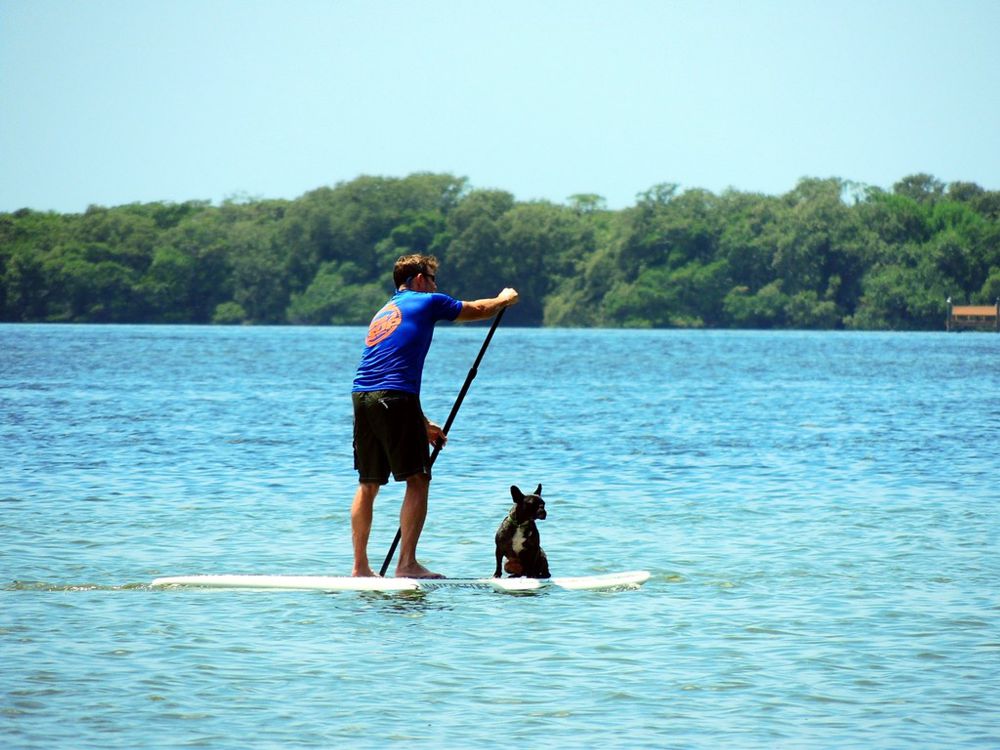
Asegúrese de que tengan un dispositivo de flotación personal (PFD) seguro para su seguridad y enséñeles cómo mantener el equilibrio y permanecer seguros en la tabla.
Consejos para principiantes sobre el paddle surf
¿Es difícil practicar paddle surf ? Ser bueno en este deporte no es demasiado difícil. Sin embargo, si eres principiante, seguir los consejos que se indican a continuación puede ayudarte a evitar errores comunes y a aprender más rápido.
- Asegúrese de que la marca de su remo de SUP esté orientada en dirección opuesta a usted y que la pala esté completamente sumergida en el agua.
- Recuerde que la postura y la posición adecuadas son cruciales para garantizar que tenga la mejor remada posible y mejorarán su técnica de remo.
- De manera similar a andar en bicicleta, tendrás más estabilidad en tu tabla de remo si tienes mayor impulso.
- Cuando estés remando, nunca mires hacia abajo, ya que podrías perder el equilibrio y caerte de la tabla de SUP.
- Evite inclinarse demasiado hacia adelante al utilizar una tabla de SUP.
- En posición de pie, intente pararse con las rodillas desbloqueadas y erguidas.
- Si le resulta difícil mantener el equilibrio al remar, concéntrese en cualquier cosa en la tierra o en el agua y comience a moverse en esa dirección para ayudarlo a deslizarse por el agua.
- Para girar la tabla, debes empujar hacia atrás y sumergir la pala del remo en el agua. Antes de hacerlo, asegúrate de colocar los pies en una posición cómoda.
Si tienes alguna dificultad en el agua, considera usar Boost Fin. Es un dispositivo revolucionario diseñado para mejorar tu experiencia de remo con asistencia motorizada. Permite a los practicantes de remo alcanzar velocidades de hasta 5 mph, lo que reduce el esfuerzo de remar. El dispositivo cuenta con un motor de aleta eléctrico que se puede conectar a cualquier tabla en 5 minutos, incluidas las tablas de remo y los kayaks. Proporciona un empuje potente, equivalente a la fuerza de 15 personas remando en una canoa, lo que te ayuda a cubrir más distancia con menos fatiga.
La aleta Boost Fin tiene una batería de larga duración que permite una sesión de remo promedio de 60 a 90 minutos. Un controlador fácil de usar permite a los practicantes de remo controlar su impulso: una pulsación prolongada proporciona un impulso sostenido y un toque rápido proporciona una breve ráfaga de velocidad.
Atrapa más olas sin esfuerzo
¿Es difícil practicar paddle surf? Este artículo ha aclarado tus dudas sobre la dificultad de este deporte. En general, el paddle surf es un deporte versátil y no resulta complicado para un principiante iniciarse y seguirlo. Siempre es mejor maniobrar el remo por primera vez en aguas tranquilas. Y recuerda aplicar nuestros consejos anteriores para obtener un mejor rendimiento.
Si te sientes cansado o desafiado para atrapar olas, contacta a Boost Surfing para obtener más información sobre nuestras Boost F in , un motor eléctrico de aleta para tus SUP. Te ayudará a surfear de una manera totalmente nueva y te brindará una experiencia que te cambiará la vida.


Compartir:
Dónde hacer surf en junio: los 14 mejores destinos para un viaje de surf en verano